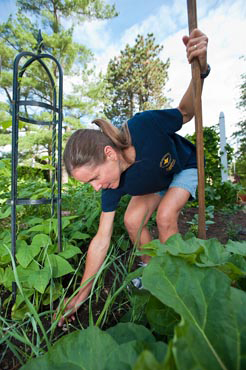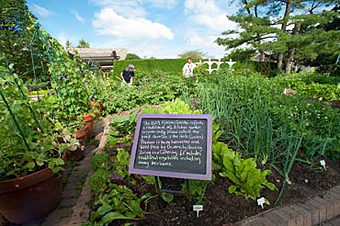Keeping it local: UW-Madison diners get ‘homegrown’ veggies
A new local food initiative on campus is starting very close to home.

Monica Theis, senior lecturer in the Department of Food Science, harvests an assortment of vegetables, including carrots, beets and lettuce, from a vegetable garden inside the Allen Centennial Gardens. Theis has been growing a variety of vegetables in the garden this summer to supply fresh produce for Frank’s Place, the dining facility in Holt Commons, as part of new local-food initiative at UW–Madison.
Photo: Bryce Richter
For the first time this summer, UW Housing’s Dining and Culinary Services is sourcing some of its produce from a small plot in Allen Centennial Gardens on campus. Diners at Frank’s Place — the dining facility in Holt Commons — have been enjoying fresh greens, radishes and onions grown just a few hundred feet away, and some of the lettuce in the Babcock Dairy Store’s sandwiches and salads may have had a shorter trip to the store than the patron eating it.
The vegetables are growing just west of the historic house in Allen Centennial Gardens, in a raised bed designed in the style of the traditional “kitchen garden” common in late 19th century Wisconsin.
Four years ago, when UW–Madison food science instructor Monica Theis assumed responsibility for the vegetable garden, she began to broaden its use as an educational tool. She got students involved and began experimenting with different practices that might help bring gardening to schools and other organizations.
The focus on the growing practices and garden itself were tremendously beneficial, she says, “but it felt unfinished.” With no specific plan for her plot’s bounty, she gave away the fruits of her labor throughout the growing season to volunteers and colleagues.
Diane Erb, food manager of Frank’s Place — the dining facility in Holt Commons — can now restock her salad bar by walking out her door and across a parking lot.
This year, she approached the campus dining services to see if they would be interested in featuring hyper-local foods, extending the garden’s lessons from ground to plate.
“Since I’m the unit closest to the garden, they asked if we could utilize some of this produce, and I said, certainly!” says Diane Erb, food manager of Frank’s Place. She can now restock her salad bar by walking out her door and across a parking lot. “I have a sign that says where it comes from, from over here at Allen Gardens. We advertise what we’re doing.”
Much of the appeal of local food is a matter of taste, Theis says. “The difference between pulling something out of a garden compared to anything that’s traveled — the flavor difference is remarkable.” But as a food science professional, her interest in sourcing local foods runs much deeper.

The kitchen garden is a natural outgrowth of the educational mission of the Allen Centennial Gardens and plays well into its theme this year of “Ornamental Edibles,” says garden director Ed Lyon. Beautiful and uncommon varieties of edible plants have been incorporated into beds and borders throughout the gardens.
Photo: Bryce Richter
“It’s also about supporting local economy and the sustainability of less transportation,” she says. But using local foods within the context of an institution like UW–Madison is not a simple task.
Despite growing interest and consumer demand for local foods in recent years, visible in the surging popularity of farmers’ markets and farm shares, bringing local food into the institutional food scene has proved more challenging.
“It’s gradually changing, but we aren’t at a point in the institutional market where you can just rely on that for your supply,” explains Julie Luke, associate director of Dining and Culinary Services. “You have to figure out how you can use it and have it not put you at risk for not being able to produce your menu,” for example, if an anticipated crop falls through.
Institutional food systems like schools, universities, and hospitals also present a challenge of scale that may be hard for individual consumers to appreciate.
“If we’re going to source locally for high-volume food service operations, what does it take to do that?” Theis asks. “It is way different than going to the farmers’ market and making a meal for your family. For example, the Madison Metropolitan School District produces 19,000 meals a day. How can we link into the local-food movement in that type of system?”
The partnership between the Allen kitchen garden and campus eateries has provided a chance to try it on a small scale. UW–Madison food managers are integrating the harvest into menus and salad bars for catering events and summer camps visiting campus. They hope to continue using the vegetables into the fall semester. The UW Dietetics and Nutrition Club will also use the produce in their monthly culinary events this fall.
The kitchen garden is a natural outgrowth of the educational mission of the Allen Centennial Gardens and plays well into its theme this year of “Ornamental Edibles,” says garden director Ed Lyon. Beautiful and uncommon varieties of edible plants have been incorporated into beds and borders throughout the gardens.
The selections include many heirlooms and unusually colored varieties such as burgundy okra, “Bright Lights” swiss chard and variegated strawberries, as well as a container garden to demonstrate how vegetables can be grown in small spaces. One of the goals is to help visitors understand what goes into producing food and see how to do it themselves.
“More and more, people have become disassociated from the whole hands-on element of their food. They don’t know how it grows, what it looks like in a garden,” says Lyon. Now, he’s seeing a resurgence of interest.
“There’s almost a return to the Victory Garden idea. More people are looking to grow a few things at home,” he says. “There’s no better way to learn than doing it yourself.”
Allen Centennial Gardens, including the kitchen garden, is open to the public daily from dawn to dusk.


